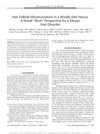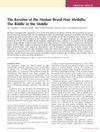A Missense Mutation Within the Helix Termination Motif of KRT25 Causes Autosomal Dominant Woolly Hair/Hypotrichosis
September 2017
in “
Journal of Investigative Dermatology
”
TLDR A mutation in the KRT25 gene causes woolly hair and hair loss.
The study identified a missense mutation in the KRT25 gene, specifically the p.Leu376Arg variant, as the cause of autosomal dominant woolly hair/hypotrichosis in a Chinese family of 23 individuals across five generations. This mutation disrupted the stability of the cytoskeleton by affecting keratin intermediate filament formation, leading to the hair phenotype. The research demonstrated the mutation's dominant-negative effect and its impact on cellular characteristics due to altered binding between K25 and K71 proteins. These findings suggested that understanding the genetic basis of such hair disorders could lead to new treatment approaches.



